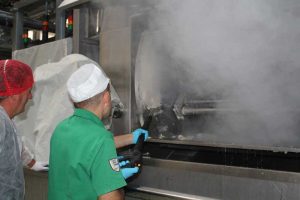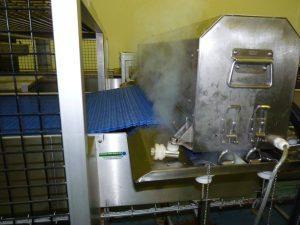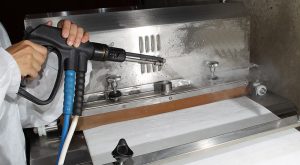One of the main factors that contribute to conveyor belt damage and wear is the accumulation of dirt and debris. Over time, these particles can become embedded in the belt’s surface, causing abrasion and corrosion. This can lead to belt slippage, reduced efficiency, and even complete failure.
Regular cleaning is essential to prevent such damage and extend the lifespan of conveyor belts. By removing dirt and debris, businesses can maintain optimal belt performance and reduce the risk of costly repairs or replacements. Effective cleaning also helps to ensure that products are not contaminated during transportation, maintaining high standards of hygiene in industries such as food processing.
Common Causes of Conveyor Belt Damage and Wear
There are several common causes of conveyor belt damage and wear that can be prevented or mitigated through effective cleaning. One of the most common causes is abrasion, which occurs when particles rub against the belt surface, wearing it down over time. This can be caused by dirt, debris, or even sharp edges on products being transported.
Corrosion is another common issue that can damage conveyor belts. When moisture or chemicals come into contact with the belt, it can cause rust or corrosion, weakening the material and reducing its lifespan. Regular cleaning helps to remove any moisture or chemicals that may have accumulated on the belt, preventing corrosion.
Impact is also a significant cause of conveyor belt damage. When heavy objects are dropped onto the belt or when products collide with each other during transportation, it can cause tears or punctures. Effective cleaning can help to identify and remove any debris that may cause such impacts, reducing the risk of damage.
The Benefits of Steam Vapour Cleaning Machines for Conveyor Belts
Steam vapour cleaning machines have become increasingly popular in recent years due to their effectiveness in cleaning a wide range of surfaces, including conveyor belts. These machines use high-temperature steam to remove dirt, grease, and grime without the need for harsh chemicals or excessive water usage.
One of the main benefits of steam vapour cleaning machines is their ability to penetrate deep into the surface of the conveyor belt, removing embedded dirt and debris that may not be visible to the naked eye. This ensures a thorough clean and helps to prevent future damage.
Another advantage of steam vapour cleaning machines is their versatility. They can be used on various types of conveyor belts, including fabric, rubber, and metal. This makes them suitable for a wide range of industries and applications.
How Steam Vapour Cleaning Machines Work to Clean Conveyor Belts
| Benefit | Description |
|---|---|
| Improved sanitation | Steam vapour cleaning machines effectively kill bacteria and other microorganisms, reducing the risk of contamination on conveyor belts. |
| Increased efficiency | Steam vapour cleaning machines can clean conveyor belts quickly and thoroughly, reducing downtime and increasing productivity. |
| Reduced water usage | Steam vapour cleaning machines use minimal water compared to traditional cleaning methods, reducing water usage and waste. |
| Environmentally friendly | Steam vapour cleaning machines do not require the use of harsh chemicals, making them a more environmentally friendly cleaning option. |
| Extended conveyor belt life | Regular steam vapour cleaning can help prevent build-up and damage to conveyor belts, extending their lifespan and reducing maintenance costs. |
Steam vapour cleaning machines work by heating water to a high temperature and converting it into steam. The steam is then directed onto the surface of the conveyor belt using a nozzle or brush attachment. As the steam comes into contact with the dirt and debris, it loosens and dissolves them, making them easier to remove.
The high temperature of the steam also helps to kill bacteria and sanitize the conveyor belt surface, ensuring high levels of hygiene in industries such as food processing. The steam vapour cleaning process is also environmentally friendly, as it does not require the use of harsh chemicals or excessive water.
To ensure effective cleaning, it is important to choose a steam vapour cleaning machine with adjustable steam pressure and temperature settings. This allows for customization based on the type of conveyor belt and the level of dirt or debris that needs to be removed.
The Advantages of Using Automatic Conveyor Belt Steam Vacuums
While manual cleaning methods can be effective, they are often time-consuming and labor-intensive. That’s why many businesses are turning to automatic conveyor belt steam vacuums for a more efficient and thorough cleaning process.
Automatic conveyor belt steam vacuums combine the power of steam vapour cleaning with the suction capabilities of a vacuum cleaner. This allows for simultaneous cleaning and drying of the conveyor belt, reducing downtime and increasing productivity.
One of the main advantages of automatic conveyor belt steam vacuums is their ability to cover large areas quickly. They are equipped with wide cleaning heads that can clean multiple sections of the conveyor belt at once, reducing the time and effort required for cleaning.
Another advantage is their ability to remove both dry and wet debris from the conveyor belt surface. The vacuum function ensures that all loosened dirt and debris are effectively removed, leaving the belt clean and dry.
Choosing the Right Steam Vapour Cleaning Machine for Your Conveyor Belt

When choosing a steam vapour cleaning machine for your conveyor belt, there are several factors to consider. Firstly, you need to determine the size and type of your conveyor belt to ensure that the machine is compatible.
It is also important to consider the power and capacity of the machine. Higher wattage machines tend to have more powerful steam output, which can be beneficial for removing stubborn dirt or debris. Similarly, machines with larger water tanks can provide longer cleaning times without the need for refilling.
Other features to look out for include adjustable steam pressure and temperature settings, as well as additional attachments or accessories that may be useful for specific cleaning tasks.
Best Practices for Maximising Conveyor Belt Lifespan through Effective Cleaning
To maximize the lifespan of your conveyor belt through effective cleaning, it is important to follow best practices. Firstly, establish a regular cleaning schedule based on the specific needs of your industry and the level of dirt or debris that accumulates on the belt.
When cleaning, start by removing any loose debris or large particles manually. This can be done using a brush or scraper before using the steam vapour cleaning machine. This helps to prevent clogging or damage to the machine and ensures a more thorough clean.
When using a steam vapour cleaning machine, ensure that you cover the entire surface of the conveyor belt, paying extra attention to areas that are prone to accumulation, such as bends or transfer points. Use the appropriate steam pressure and temperature settings based on the type of belt and the level of dirt or debris.
After cleaning, allow the conveyor belt to dry completely before resuming operations. This helps to prevent moisture-related damage and ensures that products are not contaminated during transportation.
The Role of Regular Maintenance in Conveyor Belt Lifespan Maximisation
In addition to effective cleaning, regular maintenance is essential for maximizing conveyor belt lifespan. Regular inspections should be carried out to identify any signs of wear or damage, such as tears, punctures, or fraying. These issues should be addressed promptly to prevent further damage and ensure optimal belt performance.
Routine maintenance tasks, such as lubrication of moving parts and adjustment of tensioning systems, should also be carried out according to manufacturer guidelines. This helps to prevent unnecessary strain on the conveyor belt and extends its lifespan.
It is also important to train employees on proper handling and operation of the conveyor belt system. This includes ensuring that products are loaded and unloaded correctly, avoiding excessive weight or impact that can cause damage.
The Importance of Prioritising Conveyor Belt Cleaning and Maintenance
In conclusion, effective cleaning and maintenance are crucial for maximizing the lifespan of conveyor belts. By understanding the importance of regular cleaning and implementing best practices, businesses can prevent damage and wear, reducing the need for costly repairs or replacements.
Steam vapour cleaning machines, especially automatic conveyor belt steam vacuums, offer a powerful and efficient solution for cleaning conveyor belts. Their ability to remove dirt, debris, and even bacteria without the need for harsh chemicals or excessive water usage makes them an ideal choice for various industries.
By prioritizing conveyor belt cleaning and maintenance, businesses can ensure that their production lines operate smoothly and efficiently, saving time and money in the long run. So, don’t overlook the importance of keeping your conveyor belts clean and well-maintained – it’s an investment that pays off in the long term.
FAQs
What is a conveyor belt?
A conveyor belt is a mechanical device used to transport materials from one point to another. It consists of a belt that rotates around two or more pulleys.
Why is it important to extend the lifespan of conveyor belts?
Extending the lifespan of conveyor belts can save money on replacement costs and reduce downtime for maintenance. It also helps to ensure that materials are transported efficiently and safely.
What are some common causes of conveyor belt damage?
Common causes of conveyor belt damage include abrasive materials, improper loading, overloading, and exposure to extreme temperatures or chemicals.
How can proper cleaning help extend the lifespan of conveyor belts?
Proper cleaning can remove debris and contaminants that can cause damage to the conveyor belt. It can also help to prevent the buildup of materials that can cause the belt to slip or become misaligned.
What are some tips for proper conveyor belt cleaning?
Tips for proper conveyor belt cleaning include using the right cleaning products, following manufacturer guidelines, and regularly inspecting the belt for signs of damage or wear.
What are some common cleaning products used for conveyor belts?
Common cleaning products used for conveyor belts include water, soap, and specialized cleaning solutions designed for specific types of belts and materials.
How often should conveyor belts be cleaned?
The frequency of conveyor belt cleaning depends on the type of material being transported and the environment in which the belt is operating. In general, belts should be cleaned regularly to prevent the buildup of debris and contaminants.










